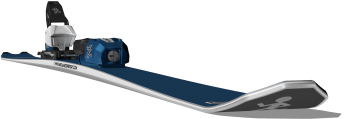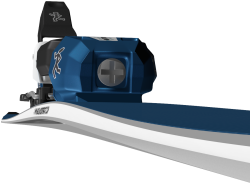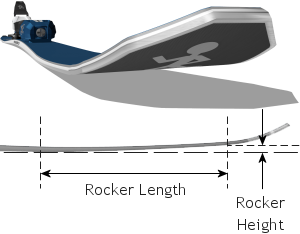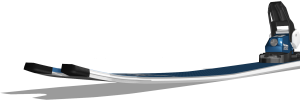Ski Cambers

Over recent years negative cambers have started to appear on skis, often called rocker skis. The rocker shapes go against traditional ski design, but they can make skis float better in powder and make skis easier to handle in the snow park. However the new rocker cambers bring both advantages and disadvantages, and aren't ideal for all types of skiing. Because of this rocker skis are best used for the type of skiing that they were designed for.
Camber Types
Each of the new cambers being used can be defined by putting different types of camber together in sections, with each of these sections having its own effect on the handling of a ski.
Positive Camber / Traditional Camber

This a section where the ski arches into the air, supported by a point at each end where the ski touches the snow. Positive camber actively pushes its length into the snow when the ski is weighted, providing the most edge contact and grip possible on hard packed snow. Therefore the longer a section of positive camber is, the better the ski will be for skiing on a hard packed piste.
Tip Rocker

A tip rocker or early rise tip, is where the skis shape starts to go upwards before the sidecut ends and the real tip starts.
Tip rockers can be used to create 2 different effects:
- A more pronounced rocker shape helps a ski to float in powder while skiing forwards, as the upward section enables the ski to climb over soft snow better. However this generally has a negative effect for on-piste performance, as less of the ski edge contacts the snow when the ski is flat or leant over at smaller angles, and there is less pressure on the edge in the rocker area when the ski is leant over further.
- A less pronounced rocker shape can be used to make changing from one edge to the other easier on hard packed snow, without having too larger effect on edge grip when the ski is leant over at larger angles. This can make a ski easier to handle on-piste, while still performing well when the skis is pushed harder.
Generally speaking the longer and higher the tip rocker section of a ski is, the better the ski will be for skiing forwards in powder, but the worse it will be for edge contact and grip on a hard packed piste. Yet a more slight rocker shape can be used to make a ski easier to handle on-piste, or in the snowpark, without any large effects on overall performance.
Tail Rocker

A tail rocker is the same as a tip rocker except for it is at the back of the ski towards the tail, and will make the a ski easier to ski backwards in powder. Again the longer and higher this section is the easier skiing backwards in powder will generally be, and the more the ski's piste handling capabilities will decrease. Tail rockers can also help with riding forwards in powder as they mean that the ski does not need to sink as deep into the snow overall, although this effect is less pronounced than the difference a tip rocker makes. As with tip rockers, tail rockers can also be used on piste or freestyle skis to make them change edge and turn more easily.
Flat Camber

A flat camber section is an area where the ski is completely flat along its length, and is normally used to replace a positive camber area. Flat camber does not actively push the edges in this area into hard packed snow as positive camber does, but it does leave the edges on the snow enabling them to grip. Therefore a flat camber section will not have as much edge grip as a positive camber section, but it will still enable the edges to grip on hard packed snow. Because of this skis with flat sections are normally strongly intended for powder skiing, with their piste capabilities intended more for just getting to and from the powder areas. Flat camber can have its uses in freestyle skis too, as because of the decreased edge pressure it can make skis easier to turn.
Camber Shapes
By putting sections of the different camber types above together, different camber shapes can be created which are suited to different skiing preferences. The characteristics of each camber shape can vary largely though, as changing the length and height of the different camber areas used in each shape can make large differences. Below the main camber shapes are listed and described.
Traditional Camber / Full Camber


On a traditional camber ski the entire length of the sidecut is covered with a positive camber, providing the most edge contact and grip possible when on a hard packed piste. Therefore most piste orientated skis and all racing skis only use a traditional camber.
Tip Rocker


A tip rocker ski has a positive camber for most of the ski, with a tip rocker at the front. This shape retains good edge grip due to the relatively large area of positive camber, while making the skis float better in powder or easier to handle on the piste, due to the rocker shape towards the tip. The length and height of the rocker section at the front of the ski can vary largely, creating a wide range of different handling characteristics between the different tip rocker ski designs.
Tip and Tail Rocker


Skis with a tip and tail rocker have an area of positive camber in the middle section of the ski, but with rocker sections towards both the tip and tail of the ski. The length of each of these sections can change, making the area of positive camber longer or shorter, as well as moving the centre of positive camber more towards the middle or back of the ski. The length of the positive camber section can change, along with the length and height of the rocker sections. This means that different skis with this camber shape can be biased more towards riding forwards or in both directions when in powder, as well as biased more heavily towards only powder skiing, or retaining better control on the piste.
Full Rocker


A full rocker ski has a flat camber in the middle of the ski, with a tip and tail rocker at the ends. This shape makes the ski very good at floating in powder, whether skiing forwards or backwards, but due to the flat camber section, does not provide so much grip on hard packed snow. The length and height of the tip and tail rockers can also vary making a ski more or less powder specific, or better at skiing forwards or in both directions when in powder.
In the grand scheme of things rocker cambers are still in their infancy, and it remains to be seen exactly which shapes will be used the most for different types of ski, and how far through ski ranges these shapes will end up influencing. However it does look certain that they are here to stay, and will make their mark in ski design for many years to come. Some of the latest skis even have a switch on them that changes the camber from a traditional camber to a tip rocker, potentially making the advantages of either camber shape available at the flip of a switch.
On to the Bindings section.